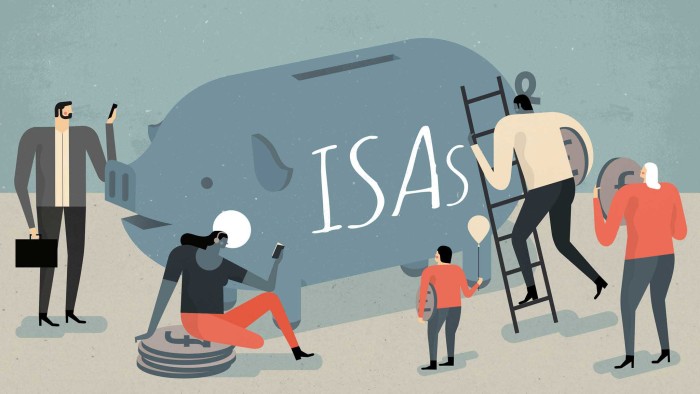How will the new Lifetime Isa work?

Simply sign up to the Investments myFT Digest -- delivered directly to your inbox.
Most chancellors like to pull at least one rabbit from their hat when delivering their annual Budget. George Osborne’s set-piece moment last March was no exception.
His surprise announcement was the Lifetime Isa, a brand new savings product specifically for “the next generation” and available to anyone between the ages of 18 and 39 on April 6 2017.
Like other Isas, the Lifetime Isa is tax efficient — but its most eye-catching feature is a 25 per cent government bonus on savings of up to £4,000 a year. Worth £1,000 per year, this could theoretically net a £32,000 bonus for an 18-year-old paying in the maximum amount every year until age 50 (when contributions must cease).
There are strings attached: funds must be used to buy your first home (worth up to £450,000) or locked away until you are 60, otherwise heavy penalties apply to withdrawals.
Like a conventional Isa, you can hold your money in cash or gain stock market exposure by investing in funds and individual stocks, and your assets will grow tax free.
While the Lisa has been described as industry experts as “free money”, its dual purpose of encouraging both home purchase and retirement saving has drawn criticism. Michelle McGrade, chief investment officer broker of TD Direct Investing, told the FT the Isa risked being “confusing”, while Steven Cameron, pensions director at Aegon, says the two aims of saving for a home and saving for retirement are “incompatible” as they require very different investment strategies.
Meanwhile experts, including former pension ministers Sir Steve Webb and Baroness Altmann, have argued that the Lisa could tempt younger people away from workplace pension schemes, causing them to lose the benefit of employer contributions.
Other critics have said the savings account will disproportionately benefit those who already have spare cash or wealthy parents, making it little more than a ready-made trust fund for the rich. Millennials, meanwhile, are faced with rocketing rents, graduate debt and depressed incomes.
All the same, if you have some cash to save and you’re eligible for a Lifetime Isa, free money could be yours. The only remaining obstacle to signing up in April is a rules and regulations bottleneck. Retail brokers such as Barclays Stockbrokers and AJ Bell YouInvest say they are still waiting for the City regulator to issue the final rules, so they will not be able to launch the Lisa in time for the new tax year in April.

Where can I get a Lifetime Isa?
Not many places. Hargreaves Lansdown is the only major retail broker to offer one, with Barclays, TD Direct Investing and Fidelity Personal Finance all saying they will not be offering one from April.
Smaller investment groups with an interest in millennials will also be offering one. Nutmeg, the robo-adviser, plans to offer it as a tax-efficient wrapper for its existing portfolios, while Money Box, the micro-investing app, says it will create a new investment portfolio specifically for those saving for a home.
It is possible that some high street banks could offer a cash-only version, although none have so far announced plans to launch a product.
How can I invest using the Lifetime Isa?
In the same way as you would through a stocks and shares Isa. Depending on the investment platform that you hold the account with, you can invest in shares, funds or a combination. Your money can grow in two ways — capital growth (assuming the value of the share price or funds you are invested in rises) as well as dividend payments. These are paid into the Isa at regular intervals, and can be reinvested. Because Isas are tax-free savings accounts, you will not have to pay any capital gains tax, dividend tax or income tax on the money inside them. But remember — the value of your investments can go down as well as up.
Can I keep my existing stocks and shares Isa, and open a Lifetime Isa as well?
Yes. You can still hold other Isa accounts, but the total amount that you save into all of them in the new tax year must not exceed £20,000. Assuming you subscribe the maximum £4,000 to the Lifetime Isa in April, you could still pay up to £16,000 into a stocks and shares Isa in the same tax year.
How will the bonus work?
The government will transfer the bonus money directly into your Lifetime Isa account. This is calculated as 25 per cent of the amount of cash you pay in, up to a maximum of £1,000 per year.
For the first year following the Lisa’s launch — the tax year ending in April 2018 — the bonus will be paid in a lump sum at the end of the year. From then on, the bonus will be paid monthly.
Isa Guide 2017
FT Money

Isas: still the best investment after nearly 20 years
What every parent needs to know about the Lifetime Isa
Junior Isas — how to invest for your children
Where can I get the new Lifetime Isa?
The best and worst rates on cash Isas
Investors play the waiting game for Innovative Finance Isas
Is the Lisa a stalking horse for pension reforms?
Independents add so much value to your portfolio
Podcast: FT Money Show Isa special
Even if the value of your investments increases, remember the bonus is only paid on the amount of the cash you pay in, not on the value of the funds in the account. Assume you pay in £4,000 on day one and your investments do remarkably well. By the end of the year, their value has risen to £6,000. Your annual bonus will be £1,000 (25 per cent of £4,000 you paid in) and not £1,500 (25 per cent of the closing balance). The same applies if stock markets fall, and the value of your funds falls below the amount of cash you initially invested.
Will the government bonus be reinvested automatically?
The bonus money will be paid in cash and retained within the Isa wrapper, but investors will have to decide what to reinvest the money in. Hargreaves (one of the few platforms that will carry a Lifetime Isa product from launch) says that just as with a normal stocks and shares Isa, customers can either instruct the broker to reinvest the cash automatically into whichever shares or funds they hold within the Lisa as it comes in, or they can log in to their account to manage the cash manually.
How will the exit penalties work?
Under the government plans, savers who access their cash before the age of 60 or for any other purpose than to buy a first home face stiff exit penalties that will see them lose 25 per cent of any withdrawals (unless they are terminally ill).
In December, however, the government said it would waive this controversial “exit penalty” for the tax year ending in April 2018. Jane Ellison, the financial secretary to the Treasury, told the House of Commons that this was because the bonus would be paid in a lump sum at the end of the first year. Savers triggering the penalty will simply not receive the bonus.
How much will it cost?
Most providers are charging the same as for any other stocks and shares Isa. For Hargreaves Lansdown, that is 0.45 per cent of whatever you put in and then the cost of whatever funds you purchase. Robo-adviser Nutmeg is also making its standard offering and charging 0.75 per cent for management of a suite of passive funds, plus the underlying cost of the funds (which Nutmeg says averages 0.19 per cent per fund).
So if this is a product for retirement, should I use it instead of my workplace pension?
The answer for most people is “absolutely not”. Workplace pension schemes usually come with employer contributions, and these are often worth more than the £1,000 a year bonus. Plus, you will receive tax relief on pensions contributions. If you are already paying the maximum annual allowance of £40,000 into your workplace pension (the sum of the employee’s and employer’s contribution) then it makes sense to open a Lifetime Isa as an extra account.
Can I use the bonus for a housing deposit?
Yes, you can use the bonus from your Lifetime Isa for a deposit, unlike with the Help-to-Buy Isa, which only made the deposit available once the house had already been purchased. The money is handed over to your conveyancer, but the condition is that the exchange happens less than 90 days from that point.
And what happens if the exchange happens after that?
Paperwork. HMRC can give you an extension, but only if the conveyancer writes to them to ask for it. If something goes wrong with the house purchase or the deal falls through for some other reason, the funds can be returned to the Lisa but the amount returned must be the same as that which left the account. The Treasury says that if the cash has somehow accrued interest in 90 days, you can keep it and need not return that to the Lisa.
So after one year, can I put £4,000 in at the start of the tax year and then receive £1,000 from the government one month later?
Yes, once the bonuses are paid monthly (from April 2018) — but then it will not be possible to put any more cash into the Isa for the rest of the tax year. The Lifetime Isa can hold a maximum of £4,000 per year from you plus £1,000 from the government.
Assuming that your contribution and the bonus is invested straight away, filling it up early will maximise the amount of cash fully invested through the tax year.
Is there a cap on the price of the home?
Yes. Lisa money can only be used to buy homes priced at £450,000 or less regardless of where in the UK they are. This is more generous than the Help-to-Buy Isa, which capped the property values at £250,000 if they were outside London and £450,000 if in London.
If I already have a Help-to-Buy Isa can I open a Lifetime Isa?
Yes. In fact, for those saving for a home, it could be a good idea to have both. Both products offer a 25 per cent government bonus for those buying a home. However, while you can invest up to £4,000 annually in a Lisa, attracting a top-up of £1,000, the Help-to-Buy Isa only allows a maximum annual saving of £2,400 and attracts a government bonus of £600 a year. When the account is first opened, savers can deposit a lump sum of £1,000, which will attract a government bonus of £250, meaning the bonus from the first year of saving could be worth up to £850.
More about Lifetime Isas
Lifetime Isa exit penalty to be waived in first year
Lifetime Isa — savings magic or future scandal?
Pensions are broken — and Lisa won’t fix them
The Help-to-Buy Isa — which can only hold cash and not stocks and shares — will close to new savers in November 2019, although money can still be paid into existing accounts until 2029.
While it is possible to invest in both kinds of Isa and attract bonuses on both, the government says savers cannot use the bonus from both for their first home. However, it is possible to “roll” the savings from the Help-to-Buy Isa — including the government bonus — into the Lisa, which can then be used for the deposit on a home.
Is there anything else I should bear in mind?
The Lifetime Isa is a brand new product. Providers have already complained that there are not enough details about how it will work in practice. This is why many of them have decided not to launch a product straight away. The amounts that savers can subscribe, the size of the bonus and the age restrictions could all potentially be changed by future governments.
Do you have any further questions about the Lifetime Isa? Comment below, or email money@ft.com
Comments